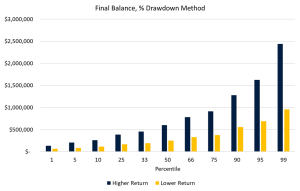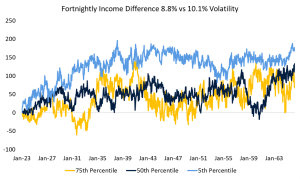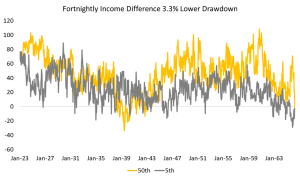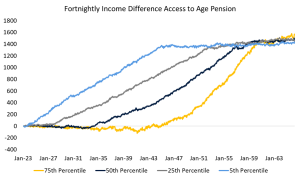
Federal Budget October 2022
28/10/2022
How to make sure your children are ready to eventually take over your wealth
01/12/2022 Key Points: Risk management is a key element of active portfolio management. Generating outperformance in down markets (via reducing risk) versus generating the same outperformance in up markets (via increasing risk), can have a materially different journey for the end investor. A portfolio which generates alpha by reducing risk will generally exhibit lower volatility and be exposed to less sequencing risk than the alternative. In this month’s Market Update, we demonstrate quantitatively the impact of this on a hypothetical household[1] using our in-house retirement income model. Our retirement income model uses a Monte-Carlo simulation to model the path and distribution of potential fortnightly household investment income streams using a variety of assumptions such as balance, expected returns, volatility, time horizon, drawdown method, household composition and assets and age pension eligibility. In practice the full set of results looks like the charts below. However, we summarise the outcomes into percentiles for ease of interpretation. To interpret a percentile, picture ranking all outcomes worst to best. The 50th percentile is the outcome in the middle, it is the average and most likely. The 25th percentile is the outcome halfway between the absolute worst and the middle. It is a bad outcome, but 75% of the simulations have a better outcome. We also focus on the left-hand side of the distribution (50th percentile – the median result, and worse) as individual investors tend to care more about not having enough in retirement rather than having too much. Income Model, Full Output, $1M Starting Balance, No Pension Source: Drummond Capital Partners To quantify the relative performance of an actively managed portfolio versus a passively managed portfolio, we compare the relative performance of our Affinity Strategic Series Growth portfolio (70% growth assets, 30% defensive assets) versus its Strategic Asset Allocation (SAA) since inception. When reviewing relative returns, volatility, and sequencing risk, we exclude the impact of the age pension. We address how the age pension can impact the results at the end of the Market Update. All of the analysis is pre-tax, and post inflation (assuming 2.5% inflation). We have adopted a dynamic total return approach to retirement income, where the amount drawn is a function of expected return and residual investment horizon. This is essentially a function which aims to, as smoothly as possible, draw down capital to zero (or level of desired bequest) over the investment horizon. Returns The most obvious place to start is investment returns. All else equal, higher returns should lead to improved retirement income, as there is a higher capital base from which to draw on. Since inception, the Affinity Strategic Series Growth portfolio has outperformed its SAA by 2.3 percentage points per annum. Below, we model the difference in income from two simulations, one with an expected real return of 3.1% (the 10 year real expected return for the Affinity Strategic Series Growth Portfolio in the 2022 SAA Review) and the other of 5.4% (adding the excess return generated since inception versus the SAA). These performance figures in absolute and relative terms are by no means guaranteed but are simply shown to highlight the potential spectrum of retirement income. At the 50th percentile (the median outcome and yellow line), average income over the forty-year horizon is on average $560 per fortnight higher ($2,060 versus $1,500). At the fifth percentile (a very bad outcome), fortnightly income is on average $300 per fortnight higher. Source: Drummond Capital Partners Using a % based[2] drawdown method rather than a dynamic method also has a large impact. Average income at the median outcome is $60 per fortnight higher, but the final balance is around $350,000 higher ($600,000 versus $250,000)[3]. Source: Drummond Capital Partners Volatility The impact of higher returns on portfolio outcomes is not unexpected – the whole active investment management industry is largely built around trying to deliver better returns. However, the bumpiness of the journey also matters, particularly if your ride overall, is disappointing. Below, we repeat the analysis we undertook for higher expected returns and apply it to lower expected volatility. Again, we use the volatility difference between our Affinity Strategic Series Growth Portfolio and its SAA since inception, to provide the alternative path (8.8% vs 10.1%). The impact here is less pronounced than expected returns, but still meaningful. At the median outcome, average income is $40 per fortnight higher in the lower volatility portfolio. However, importantly, in the left-hand side of the distribution (lower percentile values) this impact grows (to $130 per fortnight at the fifth percentile and $85 per fortnight at the 25th percentile). The effect is even positive at the 75th percentile, though less so ($40 per fortnight). Source: Drummond Capital Partners Whenever negative cash flows are introduced, even with the same expected return, a lower volatility portfolio should provide a higher overall income than a higher volatility portfolio. This benefit grows as investment outcomes become worse, demonstrating the benefit of lower volatility to individuals who are concerned with certainty of income. It also highlights a very important point around how active returns are generated. If you add alpha via increasing portfolio risk, some of this alpha will be offset by higher volatility. If you add alpha while also reducing portfolio risk, the portfolio will benefit from both. Sequencing Risk A concept which is often written about in retirement income literature is sequencing risk. The point at which an investor moves from accumulation to decumulation is very important and often out of their control. Due to active management, the Affinity Strategic Series Growth Portfolio fell by 3.2 percentage points less than its SAA during the Covid market drawdown in March 2020. Below, we show the impact of beginning a decumulation phase with a 3.2% lower balance on income. Though 3.2% does not seem like a lot – in this scenario it is a starting balance of $968,000 versus $1,000,000, it has a substantial impact on the potential income generated from the investment. At the 50th percentile average fortnightly income is $50 higher than with the lower starting balance. This highlights the benefit of preserving capital even if only a little when an investor is close to the decumulation phase. Source: Drummond Capital Partners Age Pension The age pension is a very important consideration when modelling retirement income, particularly for lower balance households. It in effect puts a floor under the income of a household, reducing the consequence of investment failure. Below, we show the difference the age pension makes to our hypothetical household over the 40-year horizon. Income across the board is higher as the pension kicks in once asset balances fall below the means test threshold. The point at which this relativity maxes out (to the value of the full age pension) occurs earlier in the lower percentile simulations, reflecting lower investment balances and thus, earlier eligibility for a full pension. Source: Drummond Capital Partners The interplay between investments and the age pension is an important conversation for individual investors to have with their trusted advisors. For those with lower balances it will likely be the most important retirement consideration. For those with high balances, it may be irrelevant. In addition, individuals should weigh the likelihood that the age pension will still be available at its current rate with its current eligibility criteria in the coming decades given the poor outlook for the Federal Budget balance and rising dependency ratios. Adding Up the Little Things The above analysis plays a key role in portfolio management and investment philosophy at Affinity Private Advisors, where we strive to deliver our clients a better investment journey. The best outcome for our investors is for us to add most of our outperformance by reducing risk in weak markets. Our proven tactical asset allocation process has been successful in 2018, 2020 and the current 2022 bear market. These outcomes increase expected returns, lower volatility, and improve drawdowns (sequencing risk) for investors. In our opinion, this is a better approach to active management than simply adding structural risk to a portfolio and hoping markets go up. [1]This hypothetical household contains married homeowners, eligible for the age pension, with $1,000,000 invested in financial assets, $80,000 in non-financial assets, with a forty-year investment horizon and no desire to bequest any of their wealth. [2] Drawdown rate is 6% of the portfolio per annum. [3] Recall in the dynamic drawdown approach target final balance is $0, hence most of the impact is felt through income rather than financial balance. This is prepared by Drummond Capital Partners (Drummond) ABN 15 622 660 182, AFSL 534213. It is exclusively for use for Drummond clients and should not be relied on for any other person. Any advice or information contained in this report is limited to General Advice for Wholesale clients only. The information, opinions, estimates and forecasts contained are current at the time of this document and are subject to change without prior notification. This information is not considered a recommendation to purchase, sell or hold any financial product. The information in this document does not take account of your objectives, financial situation or needs. Before acting on this information recipients should consider whether it is appropriate to their situation. We recommend obtaining personal financial, legal and taxation advice before making any financial investment decision. To the extent permitted by law, Drummond does not accept responsibility for errors or misstatement of any nature, irrespective of how these may arise, nor will it be liable for any loss or damage suffered as a result of any reliance on the information included in this document. Past performance is not a reliable indicator of future performance. This report is based on information obtained from sources believed to be reliable, we do not make any representation or warranty that is accurate, complete or up to date. Any opinions contained herein are reasonably held at the time of completion and are subject to change without notice. .The Little Things Matter










